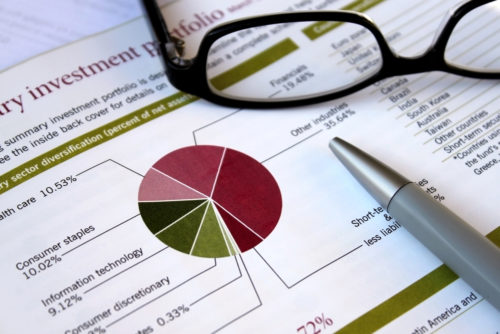An investment portfolio holds all of your financial assets. This can include a mix of stocks, bonds, cash, and more. It’s important to develop an investment portfolio to organize your investments so you can reach your financial goals. With the right mix in your investment portfolio, you can earn a return. Learn more about creating an investment portfolio and choosing the investments that are right for you.
Table of Contents
Types of Assets
Investment portfolios can hold a wide range of assets. Asset allocation is a big part of creating an investment portfolio. Each asset that you have fits into a category of different securities. For instance, equities are stocks that don’t offer fixed returns; fixed-income securities can include bonds and certificates of deposit (CDs). Here, we’ll discuss the different types of securities you can include in your investment portfolio.
- Stocks grant you partial ownership of a company. Investors own stock in the hopes that they’ll be able to sell it for a profit one day. As a stock appreciates, its value increases. When that happens, an investor can choose to sell their stock for a profit or continue to hold onto it if it pays dividends. These are payments made to shareholders quarterly, as long as the company continues to be profitable.
- Government bonds are a debt-based investment in which you loan money to the government to earn an agreed rate of interest. The government sells bonds to help raise funds to spend on new projects or infrastructure. Investors purchase bonds to get a set return at regular intervals.
- Corporate bonds are debt security sold to investors by a corporation. The bond is typically backed by money the company will earn from future operations. In some cases, a company’s physical assets are used as collateral for bonds. They are a higher risk for investors than government bonds, but they do earn a higher rate of interest.
- Exchange-traded funds (ETFs) are a collection of securities, like stocks, commodities, bonds, or a mixture of securities that track an underlying index. The most common example is the SPDR S&P 500 ETF (SPY), which tracks the S&P 500 index. ETFs are marketable securities that can easily be bought and sold. The price of an ETF fluctuates throughout the day, giving the investor more control of the price they buy or sell at.
- Mutual funds are a financial vehicle operated by a professional money manager that includes money collected from many investors. This money is pooled and invested in securities like stocks, bonds, money market accounts, and other investment assets. The money manager allocates the funds used in each investment in order to make the most money for investors.
- Bond funds are a fund that invests in bonds and other debt instruments. The debt that the fund invests in depends on the focus, but investments can include government, corporate, municipal, and convertible bonds, as well as other debt securities.
- Real estate investment trusts (REITs) allow you to invest in large-scale, income-producing real estate, such as office buildings, malls, apartments, hotels, resorts, or warehouses. This type of investment can also include mortgages and loans. A REIT doesn’t develop real estate properties to resell them as other real estate companies do. Instead, they buy and develop properties to use them as part of an investment portfolio.
How to Build an Investment Portfolio
Not all portfolios are the same. Depending on your goals, yours can look very different from someone else’s. However, there are a few common characteristics to consider. Here’s a closer look at what your investment portfolio should look like.
Diversification
Your best defense against a financial crisis is a diversified portfolio. Spreading the money you invest around the market reduces your risk of loss. This means you should invest in a variety of securities, including stocks, bonds, and commodities. Make sure your money isn’t too dependent on one particular asset. Investing all of your money in one place is extremely risky. Diversifying your funds ensures that you always come out on top. No matter which way the economy goes, a diversified portfolio will have some asset that benefits, offsetting other assets losses.
Determine Your Assets: Conservative vs Aggressive
Conservative investments are often useful for passive investors since they don’t expose the investor to many risks. Conservative investors put priority in preserving capital over market returns. They seek to protect their investment portfolio by choosing low-risk securities like fixed-income securities and money market accounts. When observing a conservative investment strategy, half or more of your portfolio is typically held in debt securities rather than equities.
On the other hand, investors who are interested in immediate gains from their portfolio may favor more aggressive and riskier assets. Capital appreciation is a primary investment objective in aggressive strategies. Ultimately, a good portfolio should balance these elements to expose the investor to opportunities for short-term gain while not being overly risky or dependent on market fluctuations.
Examples of Investment Portfolios
What your investment portfolio looks like is determined by your overall financial goals. No two investment portfolios are alike because no two investors are alike. Below are two examples of investment portfolios; one demonstrates an investor who wanted a safer, more conservative portfolio, and the other typifies an investor who wanted to take more risks to achieve short-term gains.
A conservative investment fund will typically allocate between 20% and 50% of its portfolio assets to stocks. Around 50% to 80% of the assets are a combination of bonds and cash. Conservative portfolios have a time horizon of immediate to longer than three years, as these investors are not willing to accept periods of extreme market volatility. A time horizon is the length of time over which an investor hangs onto an asset.
Below is an example of a conservative investment strategy; in this case, the investor wanted a safer portfolio. The asset allocation in this conservative portfolio is 25% stocks, 45% bonds and 30% cash (money market):
- 25% large-cap stock (index);
- 5% small-cap stock;
- 5% foreign stock;
- 50% intermediate-term bond;
- 15% cash/money market;
Aggressive investors, on the other hand, have a time horizon of longer than 10 years because of high allocation to stocks. These investors are willing to accept periods of extreme ups and downs in market account value in exchange for higher returns. An aggressive investor’s portfolio might be 85% stocks and 15% bonds by mutual fund type, with their investments broken out as such:
- 30% large-cap stock (index);
- 15% mid-cap stock;
- 15% small-cap stock;
- 15% foreign or emerging stock;
- 25% intermediate-term bond;
Overall, the type of portfolio you choose will depend on whether you want to be aggressive or conservative, and diversifying your portfolio can help you weather tough times in the market.
Image Source: https://depositphotos.com/





